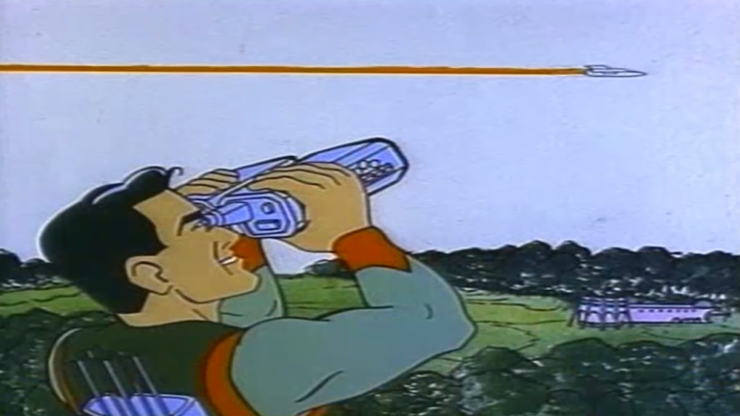Todd: And we’re back! Thanks to everyone who commented on our previous post, Five Forgotten Swordsmen and Swordswomen of Fantasy! In our constant quest to improve ourselves through shorter titles, this one is called Five Classic Sword-and-Planet Sagas.
Howard: Sword-and-planet is one of my favorite genres. It is a field of unfettered imagination, and the men and women who wrote it were concerned chiefly with story and giving free rein to their imaginations. I think that makes it a unique form of fantasy, even in a body of literature that generally prides itself on imagination.
Todd: In many ways, sword-and-planet mixes the best of science fiction and fantasy. Donald A. Wollheim is believed to have created the term “Sword-and-Planet” in the ‘60s, likely for his classic ACE anthology Swordsmen in the Sky (1964). But the genre’s roots are much older than that, and even today its most famous proponent is Edgar Rice Burroughs, who created the mold for what we think of as sword-and-planet stories with the very first John Carter novel, A Princess of Mars, way back in 1912.
Sword-and-planet and space fantasy were popular in the pulps in the 1930s, and one of the greatest SF pulps mags of all time, Planet Stories, made a specialty of it. Over the next few decades dozens of writers experimented with it, including Otis Adelbert Kline, Leigh Brackett, Robert E. Howard, Poul Anderson, Michael Moorcock, Lin Carter, Jack Vance, and Alan Burt Akers. In this piece, Howard and I are going to discuss the best S&P novels and series you’ve probably never heard of. And also Rocket Robin Hood.
Howard: No cartoons.
Todd: Right, absolutely. No cartoons. Except for Rocket Robin Hood.
Howard: Sometimes you cause me actual physical pain.
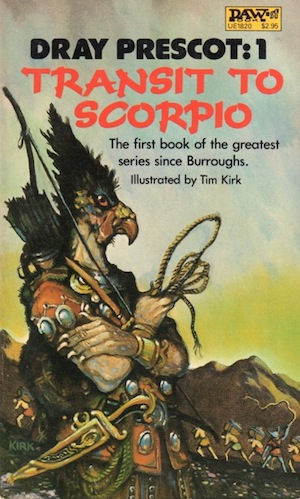
Todd: I’m going to kick it off with the Dray Prescot tales by Alan Burt Akers.
Howard: Why him?
Todd: Because he published FIFTY-TWO novels in the series, and anything that survived in the market that long deserves a look, at the very least, in my book.
Howard: I have to admit that while I’ve been curious about this series, I’ve never read it. I’ve never actually seen the first few books in the wild, or I might have attempted it early on. I always see later volumes.
Todd: It’s true the Dray Prescot novels didn’t win any awards. They were written by well-known British SF writer Kenneth Bulmer under the Akers pseudonym, in rather obvious imitation of Edgar Rice Burroughs.
In fact, like a lot of early sword-and-planet, the whole set-up is a fairly obvious copy of the John Carter novels. But Akers gives them a British spin: Instead of a Confederate soldier transported to Mars, the series features Dray Prescot, an officer in Horatio Nelson’s navy, mysteriously transported to the planet Kregen, where he becomes an agent of the secretive Savanti. Like the John Carter novels, they’re narrated in first person, “as told to Alan Burt Akers.”
Although it hewed pretty closely to the planetary romance formula set down by Burroughs, as the series progressed more sword-and-sorcery elements were introduced, with magic taking a bigger role. Some of the later books were clearly attempting to cash in on the Dungeons & Dragons craze of the early ‘80s, particularly #27, Mazes of Scorpio (1982), which is basically one long dungeon crawl.
Howard: So, inquiring minds want to know: Does a 52-book series sustain quality throughout its run? What’s the story, oh learned one? Are they ALL good? Or just the first few?
Todd: How the hell should I know? I haven’t read all of the damned things. But they move fast, and Bulmer/Akers had a flair for setting and fast action. Today they’d be marketed as Young Adult, and they certainly have that feel. I bought them as a teenager off the spinner racks of my local supermarket; they were just the right length, and the DAW covers were terrific. They featured cover and interior art by top-notch artists like Michael Whelan, Ken Kelly, Richard Hescox, Clyde Caldwell, Tim Kirk, Josh Kirby, and Jack Gaughan.
The series sold well enough that used copies are still pretty easy to find. The first 37 volumes were published by DAW between 1972 and 1988; the series was then cancelled in the U.S. But its popularity in Germany encouraged Bulmer to write another 15 novels, which were translated into German.
The entire series—all 52 novels!—has been reprinted in a series of affordable omnibus volumes by Bladud Books, under the title “The Saga of Dray Prescot.” Each fat volume contains four of the original slender paperbacks. Volumes 11-15 include the non-DAW novels, published in English for the first time.
Howard: What makes them worth a look today?
Todd: There were plenty of touches that admittedly went over my head 30 years ago, but which I appreciate today. For example, the planet Kregen orbits the star Antares, which is sometimes mistaken for Mars in the sky (“Antares” means “like Mars”). It’s a clever nod to Burroughs. On the flip side, during his travels Prescot learns of the faraway continent of “Gah,” a place of perverse customs –an obvious slam at John Norman’s Gor series. Bulmer was a clever writer in lots of ways.
Anyway, Dray Prescot is sort of a guilty pleasure. He still has lots of fans today, but I’m not expecting a Dray Prescot renaissance any time soon.
As a genre, sword-and-planet is filled with guilty pleasures, really.
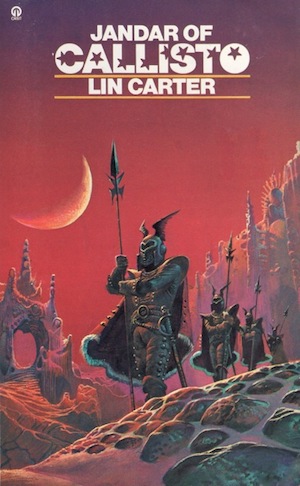
Howard: While we’re on the topic of guilty pleasures, I want to talk about one of my own: Lin Carter’s Callisto novels. Like Akers, the eight Callisto books wouldn’t exist without Edgar Rice Burrough’s Mars books.
Todd: Probably nothing on this list would exist without John Carter of Mars.
Howard: Absolutely. Technically the Mars books had a few predecessors, but none of them have had even a fraction of the impact and influence of John Carter, whose success really launched the genre.
Todd: We could spend a while discussing the true roots of sword-and-planet, like Percy Greg’s Across the Zodiac (1880) and Edwin Lester Arnold’s Gulliver of Mars (1905), or even the popular writers of the ‘20s and ‘30s, like Ralph Milne Farley (The Radio Man, 1924) and Otis Adelbert Kline (Planet of Peril, 1929), but they’re mostly of historical interest these days.
Howard: Right. Given that the ONLY sword-and-planet series most people know is John Carter of Mars, and that’s it’s one of the few you can find on your own, rather than discussing it, I’ve elected instead to focus on the Callisto books, the creations of Lin Carter. Even Lin himself would have told you that they’re derivative.
Todd: From what I understand, they’d probably be considered fan fiction today.
Howard: Nothing wrong with fan fiction, my friend. Carter almost made a career of it—he did quite a bit of pastiche writing. He was derivative by design and intention, and he loved Burroughs, mixing a little bit of Burroughsian style into much of his adventure fiction. I like him best as an editor who sincerely enjoyed older fantasy and loved to share that knowledge in welcoming and informative essays. But I also enjoy some of his short fiction, and a handful of his novels, the best of which was probably Lost World of Time.
Todd: You are going to actually TELL US about the Callisto books at some point, right?
Howard: Getting impatient? Well, I thought they were a lot of fun when I read them twenty years ago. They were popcorn reads, with melodrama and cliffhangers and all the things that Carter loved about Burroughs. They’re not supposed to be original, so don’t wander into them looking for fresh takes.
Todd: In fairness, Burroughs wasn’t particularly original either. It’s pretty clear that the aforementioned Edwin Lester Arnold’s novel Gulliver of Mars, published seven years before A Princess of Mars, was a significant influence. Both feature military men transported to Mars who have lengthy adventures and end up falling in love with a Martian princess.
Howard: Fair point. If you want to read more stories about an intrepid warrior from our world thrust into an alien environment, you could do a lot worse than the Callisto books. And while we’re discussing originality, it’s worth noting that while Burroughs tended to use the same kidnap plot over and again, the Callisto novels are more varied.
Todd: This is the series where Lin Carter puts himself into one of the books, isn’t it?
Howard: Yes! Like Akers, Lin Carter took a cue from Burroughs and pretended he wasn’t really the author, but merely the person conveying information that the TRUE author relayed about his adventures. Until the sixth book, that is, when Lin Carter himself ventures through the same portal as John Dark, renamed by the people of Callisto as Jandar (Jandar of Callisto is the first novel in the series). When Carter passes through he becomes known as “Lankar of Callisto.”
Todd: This is sounding more and more like straight-up fan fiction.
Howard: Well, you have to get into the spirit of the novels. And it was the seventies.
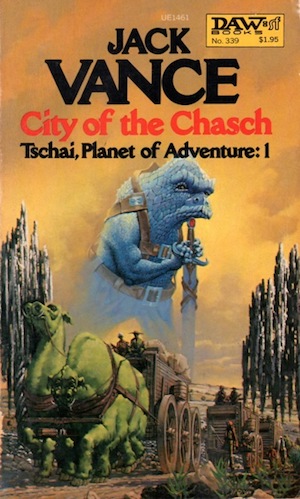
Todd: Okay, time to switch gears. I want to talk about a sword-and-planet series that I think DOES hold up well today: Jack Vance’s magnificent Planet of Adventure novels: City of the Chasch, Servants of the Wankh, The Dirdir, and The Pnume.
Howard: Great choice. I confess that I’ve only read Callisto once, and I stopped after book six (there are eight in total). But when it comes to The Planet of Adventure series, I’ve read then all twice, and will probably read them again. I know they were originally published as separate novels, but I first found the series in an omnibus that contains all four books.
Todd: The Orb collection? Yeah, that’s a great volume—published in 1993, and STILL IN PRINT, 26 years later! That should tell you something about the longevity of this series.
Howard: Vance’s world- and society-building is always, well, phenomenal, but sometimes he can get lost in the creation and focus less on the plot or the characters. In this series, though, he really channels the adventure, right from the start.
Todd: Agreed. The series kicks off with a bang: scout ships sent to investigate a mysterious distress signal crash-land on the planet Tschai, stranding lone survivor Adam Reith on an unknown world. For the next four books Reith takes on challenge after challenge in his relentless quest to return to Earth. First he attempts to repair his ship, then steal a new one, then build one, and finally he must escape the clutches of the insect-like Pnume.
Howard: I’ve heard some people refer to the main character as flat, but he’s a lot more interesting to me than many of other Vance’s characters. He’s clever and full of surprises. He drives the action and has to constantly think on his feet and invent his way out of challenging situations. Unlike Cugel the Clever, he’s also a warrior and man of honor.
Todd: What I remember most is the rich mixture of alien civilizations and strange societies Reith finds himself in. There’s the hundred-thousand-year-old culture of the reptilian Chasch, the multi-gendered feline Dirdir, the insectoid Pnume with their ten million years of history, the predatory Phung, the human client-races differentiated by selective breeding, and more… Reith constantly has to navigate their complex wars, alliances, religions, and bizarre and mysterious customs. It’s classic Vance.
Howard: Two books in the series, Servants of the Wankh and The Pnume, feature exciting sea voyages that read more like epic fantasy than science fiction. When Vance hit his stride, there really was no one like him.
Todd: That’s for sure.
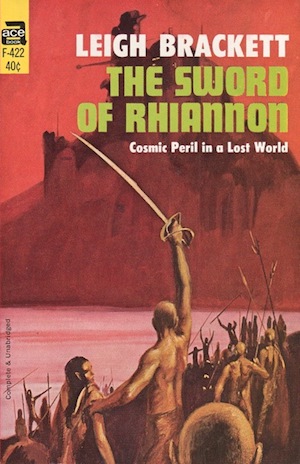
Howard: For the next item on our list, I want to return to one of my favorite writers, the incomparable Leigh Brackett. Those in the know might assume I’m getting ready to talk about Eric John Stark (whom we mentioned in our LAST column), and the trilogy of books that sent Stark out of our own solar system and onto the dying planet of Skaith.
The Skaith trilogy is pretty cool, and because one of my two older sisters happened to think they were nifty, they’re the first sword-and-planet books I ever read. But you know what? I happen to like Brackett’s The Sword of Rhiannon, aka The Sea-Kings of Mars, even better.
Todd: You’re not fooling anybody. You’re trying to jam two books onto the list. Just pick a book, dude.
Howard: Maybe. But look, if you’re only going to read one sword-and-planet by Leigh Brackett (I can’t imagine WHY you’d read just one, but whatever) I’d make it The Sword of Rhiannon. It’s appeared under both titles over the years, most famously in 1953 when it was printed as an ACE double with Robert E. Howard’s one and only Conan full-length novel, The Hour of the Dragon.
Todd: I have that book!
Howard: Knowing you and your obsession with vintage paperbacks, you probably have multiple copies. I hope you’ve read at least one of them.
Todd: I don’t want to take them out of the mylar.
Howard: You’re hopeless.
Brackett is justly called the Queen of Space Opera, but sometimes her space opera has elements of sword-and-planet, and vice versa. A lot of sub-genres are blurry at the edges. She grew up reading Burroughs and took some of her tales to a swampy Venus that was a little like Burroughs’ Amtor, but mostly she sent them to Mars.
And what a stunning, lonely, haunted Mars it is, one that should be better known. That lady could conjure prose magic. Our hero Carse is sent stumbling through a gateway into the distant Martian past, before it was a dying desert world. There are sea kingdoms, and a wicked and beautiful warrior woman, and brave heroes and stunning scenery and an overarching mystery and menace. It’s compact but powerful, and goes down like a heady wine.
Someday you need to explain to me why Leigh Brackett isn’t more celebrated. Mal Reynolds, Han Solo—she was writing characters like them decades before anyone else, and long before those two ever appeared on screen.
Todd: She was writing Han Solo after Lucas created him, too. One of the last things she wrote was the first draft of The Empire Strikes Back.
Howard: Yes, and unfortunately that’s where a lot of modern name recognition of Brackett begins and ends. If people dig deeper, they’ll find a wealth of wonderful adventures that flowed from her typewriter.
Todd: Before we discuss our last selection, I do want to mention some things we’ve skipped, like Edmond Hamiton’s Kaldar tales, Michael Moorcock’s Kane of Old Mars, and even Robert E. Howard’s Almuric. More recently, George R.R. Martin and Gardner Dozois produced two very fine anthologies of retro-SF with sword-and-planet themes, Old Mars and Old Venus. There’s plenty of great stuff out there; I encourage our readers to read widely to see what appeals to them.
Howard: Now who’s trying to jam a bunch of books unto the list?
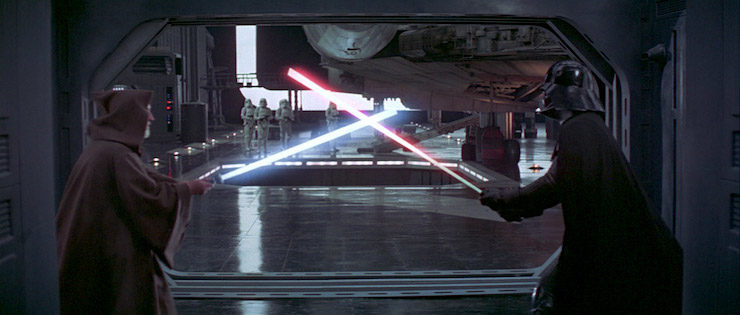
Todd: I want to close with some words about probably the greatest sword-and-planet epic of all time, the saga whose creator was a huge fan of Planet Stories and the stories of Leigh Brackett especially, and who single-handedly made it cool to mix starships and laser swords. I’m speaking, of course, of George Lucas and Star Wars.
Howard: Wait, what?
Todd: Star Wars is such an industry on its own today that people think of it as its own thing. But back in 1977, people were excitedly calling it Space Fantasy and drawing parallels with Buck Rogers and early sci-fi adventure serials. It may well be the purest sword-and-planet tale ever created.
Howard: Wait, wait. Star Wars is a space opera. I know I said earlier that there is some blurriness on the edge of any genre, or sub-genre, but come on. If we’re going to discuss visual media and Star Wars, then we have to discuss the original Star Trek, which, as everyone knows, is far superior to Star Wars.
Todd: That makes no sense. There are no swords in Star Trek! There are barely any lasers.
Howard: That’s because it has phasers, which are way cooler. But it’s space opera—and so is Star Wars, although it has a few sword-and-planet characteristics.
Todd: A FEW? It has a space princess, for God’s sake. And space wizards and laser-sword battles, and storm troopers who ride dinosaurs.
Howard: I don’t think I’m being too pedantic here—mostly Star Wars is about interplanetary journeys and spaceships and all that, and while sword-and-planet may have those things in the background, in the foreground the protagonists are struggling along with swords and riding weird beasts and dealing with ancient-level technology. If they have a blaster, then they probably only have a few shots left. The genre is basically sword-and-sorcery with a faint science fiction overlay. If we don’t put up some sign posts on the border then we might as well start talking about C.L. Moore’s Northwest Smith, and on and on…
Todd: “[I]n the foreground the protagonists are struggling along with swords and riding weird beasts and dealing with ancient-level technology…” That’s a perfect description of Star Wars right there, my friend.
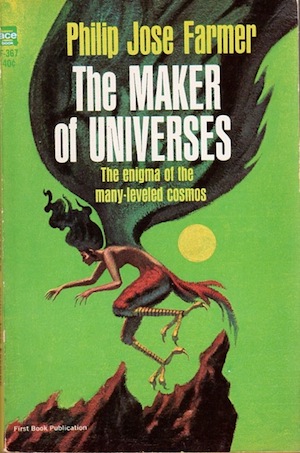
Howard: All right, since you’ve clearly lost your mind; I’ll choose the last selection: Philip José Farmer’s World of Tiers series.
Todd: Fine.
Howard: I have mixed feelings about World of Tiers. In my experience, Farmer’s series’ often started out strong and then ran out of steam, and I think this one definitely did. But the first two or three of the six novels are pretty cool, and one of them, at least, was a huge inspiration to Roger Zelazny, and led directly to one of my favorite fantasy series, The Chronicles of Amber.
Todd: I’ll have to take your word for it; I never read the later books. Still, Tiers is not a bad choice. The premise is that our world and universe aren’t actually working as we understand them, and are part of one of many pocket universes where supremely powerful individuals come to play. That sounds pretty Amber-y, but are you saying that there’s one book in the series that was more important to Zelazny than the others?
Howard: The second one, The Gates of Creation, has even more direct Amber parallels. The superpowered main character has to team up with a bunch of his relatives (who are also superpowered), and he can’t be sure whom to trust. It has a lot more going on than the other books, and if I ever re-read any of them, it will be that one. I read The World of Tiers after The Chronicles of Amber, and I immediately recognized the themes Zelazny had picked up on. It’s a very different kind of planetary adventure, and much more original in conception, as well as being more influential, than anything on this list after Burroughs.
Todd: And Star Wars, naturally.
Howard: Stop already.
Todd: You stop.
Howard: I respect World of Tiers and even like aspects of the books, although I’ve never felt strongly compelled to revisit them, as I’ve done time and again with Brackett. One ugly moment in a later book stuck in my craw so badly that it’s eclipsed all my pleasant memories of the fun escapist fare of the first few novels. Even given that this was an earlier time, Farmer’s depiction of a rape survivor was jaw-droppingly obtuse. I mean, it bugged me even as a teenager who knew next to nothing about sex.
Todd: Elaborate, please.
Howard: Here’s the thing — for the most part this genre is light adventure fare. When it’s not, the authors usually let us know early on.
Todd: Dude. I meant, elaborate on being a teenage boy who knew nothing about sex.
Howard: We’re usually dealing with frying pan-into-the-fire-style plotting, villains who might as well be twirling their mustaches, etc. I don’t turn to sword-and-planet for heavy themes. In one of the Tiers books, though, the female protagonist is raped. Later on she forgives the man who did it with a metaphorical shrug because apparently he didn’t know any better and didn’t mean anything by it and everyone just moves on. I kept reading along myself, but I barely recall anything else in that book apart from my stunned reaction.
Todd: Holy crap!
Howard: Exactly. You know that I spend a lot of time reading fiction that was published even earlier than this. I’m usually the first person to jump up and remind people that we should try to be aware of the time and place where a piece was written, and the attitudes common to the writer’s social class, etc. (without letting them off the hook for problematic choices), but this wasn’t typical in late ’60s fiction I’ve read and it sure wasn’t cool in the earlier fiction which it frankly imitates. First, when you’re writing light stories, this kind of heavy stuff doesn’t add realism, it just reads like a turd in the punchbowl. Second, if you’re going to have terrible thing happen, then you have to have characters face the consequences.
Todd: That’s appalling. I would’ve expected Farmer to know better.
Howard: Me too. I can’t explain it. The whole sequence just shows a complete lack of any kind of understanding… You know what, I’m done. I feel icky just having talked about it.
Todd: OK then. Big provisional recommendation for World of Tiers. Like, we recommend you don’t read it.
Howard: No, I’m not that knee-jerk. I still recommend the first two or three books. There’s genuine imaginative power in them, and they’re part of the genre conversation that ultimately produced The Chronicles of Amber. After that, even without the ickiness, it began to feel like Farmer’s interest dropped off and he was just spinning the series out for contractual obligations.
Todd: All right. To summarize, we’re split on World of Tiers, and also Star Wars. You have no opinion on Dray Prescot, and I didn’t weigh in on the Callisto books.
Howard: Yes.
Todd: But we both enthusiastically recommend Vance’s Planet of Adventure, and the entire sword-and-planet catalog of Leigh Brackett.
Howard: Absolutely.
Todd: And though we agree that it’s definitely not sword-and-planet, we both enjoying working in a mention of the original Star Trek whenever possible.
Howard: Naturally.
Todd: And we agree that Rocket Robin Hood is the summit of animated sword-and-planet.
Howard: I knew this would go off the rails eventually.
Todd: Hear me out. Rocket Robin Hood was a Canadian animated series produced by Krantz Films between 1966 and 1969, the same time Star Trek was on the air. For millions of Canadian kids growing up in the ‘70s—and a few lucky young Americans with decent TV reception—Rocket Robin Hood was the pinnacle of afternoon programming.
Howard: Let’s just get this over with. Go ahead. Get it out of your system.
Todd: Rocket Robin Hood and his Merry Men hide out on New Sherwood Forest Asteroid in “the astonishing year 3000.” They square off against the Sheriff of N.O.T.T, the incompetent lawman of the National Outer-space Terrestrial Territories, and his sinister master Prince John. It’s a classic retelling of all the great tales of Robin Hood, with jet-packs, spaceships, and electro-quarterstaffs.
And it is pure, undiluted sword-and-planet, with a great soundtrack inspired by Old English ballads. You can still song-along on YouTube!
Howard: All done?
Todd: Thank you.
Howard: To wrap up, I’d like to say that we might have gone on and on here with recommendations—once we get going, it can be hard to know where to draw the line. We tried to keep our focus on lesser-known or more influential works in the genre, filtered through our own experience, though I’m sure there are plenty of other great examples to talk about. We thought we should wrap things up before this turns into a book-length treatise—especially once Todd starts talking about Canadian cartoons.
Todd: Yeah, I think that brings us to a close. We’d love to hear how crazy we are for neglecting your favorite sword-and-planet series in the comments—please shout out below!
Howard Andrew Jones’ novel Upon the Flight of the Queen, the second book in the Ring-Sworn Trilogy, will be published by St. Martin’s Press in November.
Todd McAulty’s first novel The Robots of Gotham was published by John Joseph Adams Books in June of last year.










